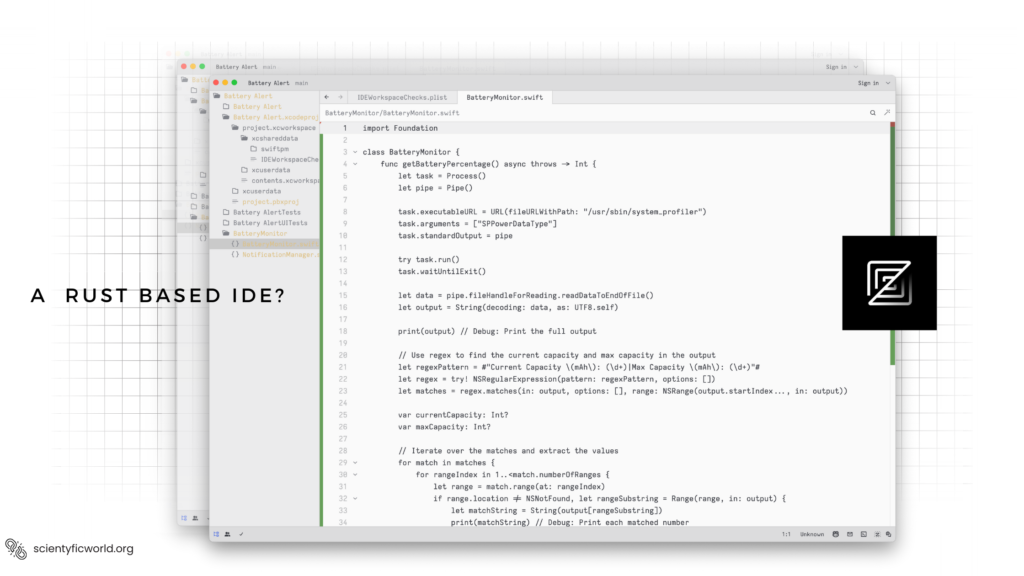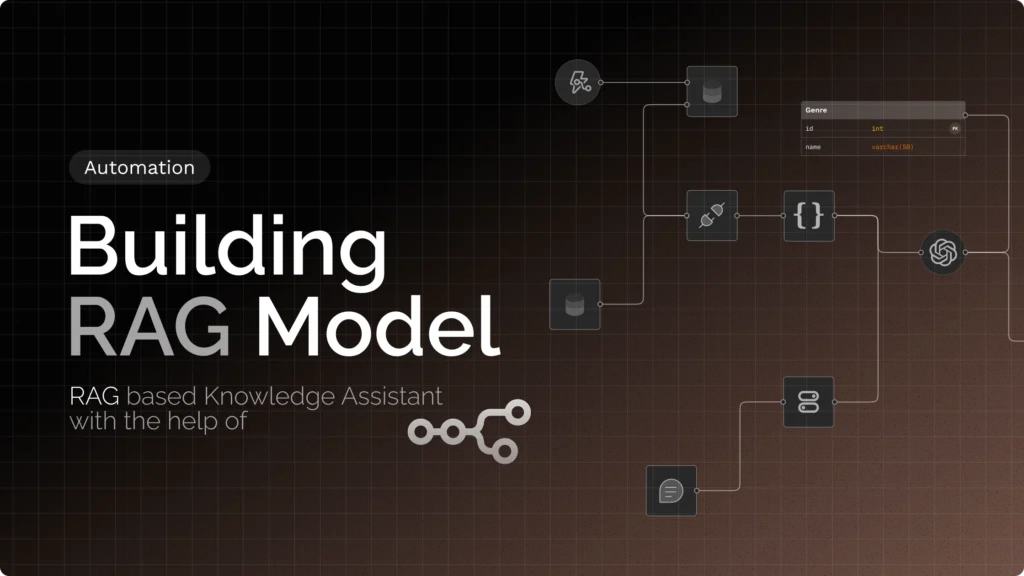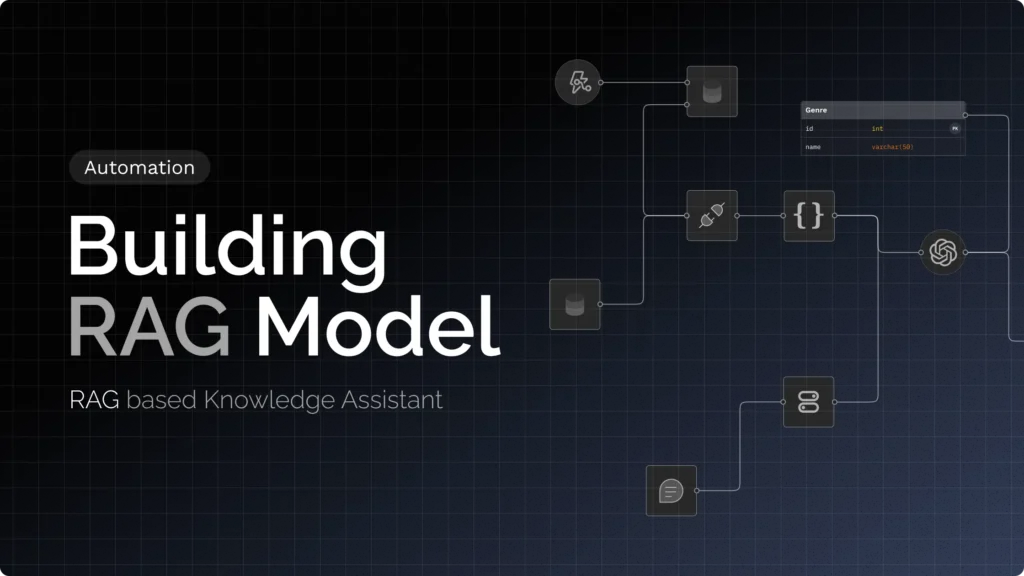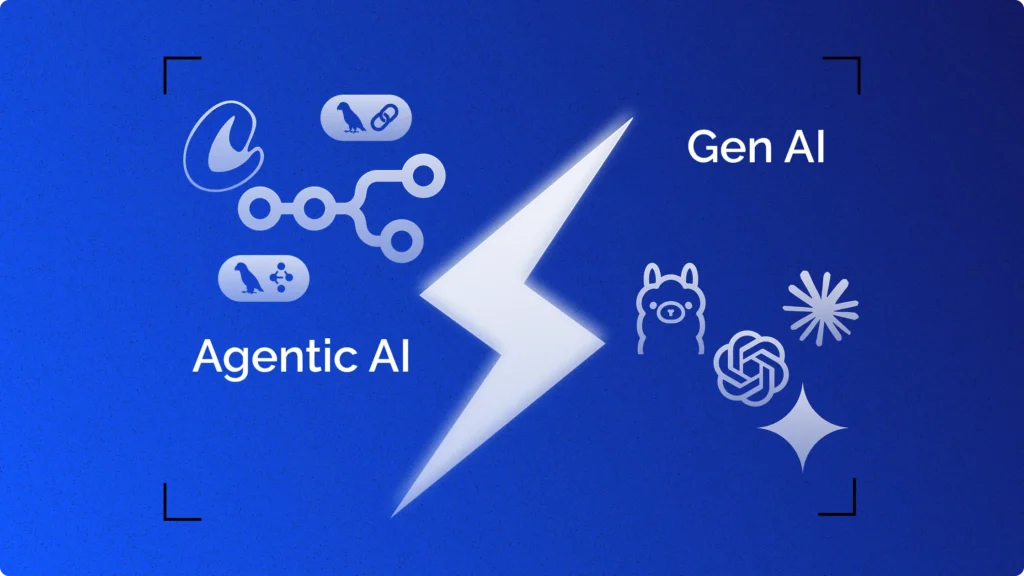The Zed code editor has rapidly gained attention in the developer community for its high-performance and collaborative editing features. Unlike traditional editors, Zed is designed from the ground up to be fast, leveraging the latest technologies in Rust and GPU acceleration to provide a seamless coding experience. Its real-time collaborative editing capabilities enable developers to work together on code from anywhere in the world, making it a valuable tool for remote teams and open-source projects.
The purpose of this blog is to provide a clear understanding of the technical architecture and performance benchmarks of Zed. We aim to dissect the innovative technologies and methodologies that underpin Zed, offering insights into how it achieves its performance and functionality. By demystifying these aspects, we hope to equip professional developers with the knowledge to effectively integrate Zed into their workflow, optimize their development environment, and contribute to its ecosystem.
What is Zed Code editor?
Zed represents a significant leap in the evolution of code editors, distinguishing itself through a unique combination of performance, real-time collaboration, and extensibility. Developed with the modern developer’s needs in mind, Zed is built on Rust, a language synonymous with speed and safety, and employs a GPU-accelerated UI framework to ensure smooth and responsive user experiences, even in complex projects.

The editor’s design philosophy prioritizes efficient and intuitive workflows. It integrates features such as a command palette, customizable key bindings similar to those found in VS Code, and Vim-style modal editing to accommodate a wide range of user preferences. This adaptability extends to its theming capabilities, offering a selection of light and dark themes and the promise of more customizable options in the future.
A cornerstone feature of Zed is its collaborative editing functionality. It allows multiple developers to work on the same codebase in real time, facilitating immediate communication and code reviews without the friction of traditional version control systems. This feature not only supports remote work dynamics but also enhances the sense of community and collective problem-solving among developers.
Zed also introduces an innovative approach to managing workspaces and projects. It provides a virtual office environment where teams can organize discussions, plan, and code within shared spaces. This environment supports nested channels for better organization, and shared documents for note-taking, and project tracking, making it an all-in-one solution for software development teams.
On the technical side, Zed’s performance benefits from Rust’s efficient memory management and parallel execution capabilities. The editor uses a novel UI rendering technique that minimizes latency and maximizes rendering performance, setting a new standard for what developers can expect from their tools in terms of speed and responsiveness.
Zed’s Technology Stack and Frameworks
Zed’s technology stack and frameworks represent a carefully chosen set of tools and libraries designed to optimize performance, enable real-time collaboration, and ensure a highly customizable user experience. At the heart of Zed’s architecture is Rust, a programming language known for its focus on safety, speed, and concurrency. This choice underpins many of Zed’s core performance characteristics, including its ability to handle complex operations with minimal latency.
Rust
Rust is the cornerstone of Zed’s development, contributing to its robustness and efficiency in several ways:
- Safety and Speed: Rust’s emphasis on memory safety—without a garbage collector—means Zed benefits from both speed and safety. Memory management errors, common in software development, are significantly reduced.
- Concurrency Made Easy: Rust’s ownership model simplifies writing concurrent, yet safe code. This is crucial for Zed, allowing it to handle multiple operations seamlessly, and enhancing the editor’s responsiveness and performance.
- Zero-cost Abstractions: Rust’s “zero-cost abstractions” mean that abstractions cost nothing in release builds. For Zed, this translates to high-level features without performance penalties, such as complex syntax highlighting and real-time collaboration features.
- Compile-time Checks: Rust’s compiler performs extensive checks to ensure type safety and manage dependencies, resulting in fewer runtime errors and bugs in Zed. This leads to a more reliable code editing experience.
- Ecosystem and Tooling: Rust’s growing ecosystem offers libraries and tools that Zed leverages for various functionalities, from parsing different programming languages with Tree-sitter to integrating other Rust-based tools and libraries efficiently.
GPUI Framework
The GPUI framework is a pivotal part of Zed’s performance strategy, enhancing its UI rendering capabilities:
- GPU Acceleration: By leveraging the GPU for rendering tasks, GPUI allows Zed to achieve high frame rates and low latency. This is essential for smooth scrolling, syntax highlighting, and rendering of complex UI elements.
- Efficiency at Scale: GPUI’s efficient use of GPU resources means that Zed can render highly detailed interfaces without compromising on performance, even on large monitors or with multiple editor windows open.
- Responsive UI: The use of GPUI ensures that UI interactions in Zed are responsive and fluid. Whether it’s opening large files, switching between tabs, or updating live previews, the experience is seamless.
- Customization and Theming: GPUI supports extensive customization and theming capabilities in Zed. Users can tailor their development environment to their liking, with changes rendered beautifully and efficiently.
- Cross-Platform Performance: While GPU acceleration can vary across platforms, GPUI is designed to optimize performance across different hardware and operating systems, ensuring that Zed offers a consistent user experience whether on Windows, macOS, or Linux.
Additional Technologies
- Tree-sitter: An incremental parsing system used by Zed Code editor to provide syntax highlighting and code understanding features. Tree-sitter enables Zed to efficiently parse and highlight code in real-time, supporting a wide range of programming languages with high accuracy.
- CRDTs: Conflict-free replicated Data Types are employed to implement real-time collaborative editing. This technology ensures that all participants in a collaborative session can make changes simultaneously without conflicts, merging changes seamlessly across distributed systems.
- WebRTC: For real-time communication, Zed likely utilizes WebRTC or similar technologies to facilitate peer-to-peer collaborative sessions, supporting features such as audio communication and screen sharing among developers.

This diagram visualizes the core components of Zed’s technology stack and how they interact to provide a high-performance, collaborative, and extensible coding environment. Rust is at the core, supporting all major functionalities including the GPUI framework for UI rendering, Tree-sitter for syntax highlighting, CRDTs for collaboration, and WebRTC for real-time communication. This structure ensures that Zed remains at the forefront of development tool innovation, offering features that are both powerful and necessary for modern software development practices.
Implementing Real-time Collaboration with CRDTs
Implementing real-time collaboration in a code editor like Zed involves complex challenges, particularly when it comes to ensuring consistency and responsiveness across all users’ sessions. Zed addresses these challenges using Conflict-Free Replicated Data Types (CRDTs), a key technology that allows multiple users to edit a document simultaneously without conflicts.
Understanding CRDTs (Conflict-Free Replicated Data Types) requires diving into how they enable distributed systems, like collaborative editors, to manage data consistency across multiple nodes without central coordination. CRDTs are designed to handle the inherent challenges of distributed computing, such as network partitions and latency, by ensuring that all participants can converge towards a consistent state, even when updates are made offline or in parallel.
Core Principles of CRDTs
CRDTs operate on two fundamental principles: commutativity and idempotence. Commutativity ensures that the order of operations does not impact the final state. For example, if two users simultaneously edit different parts of a document, the result should be the same regardless of which order their edits are applied. Idempotence guarantees that applying an operation multiple times has the same effect as applying it once, preventing duplicate changes from affecting the document state.
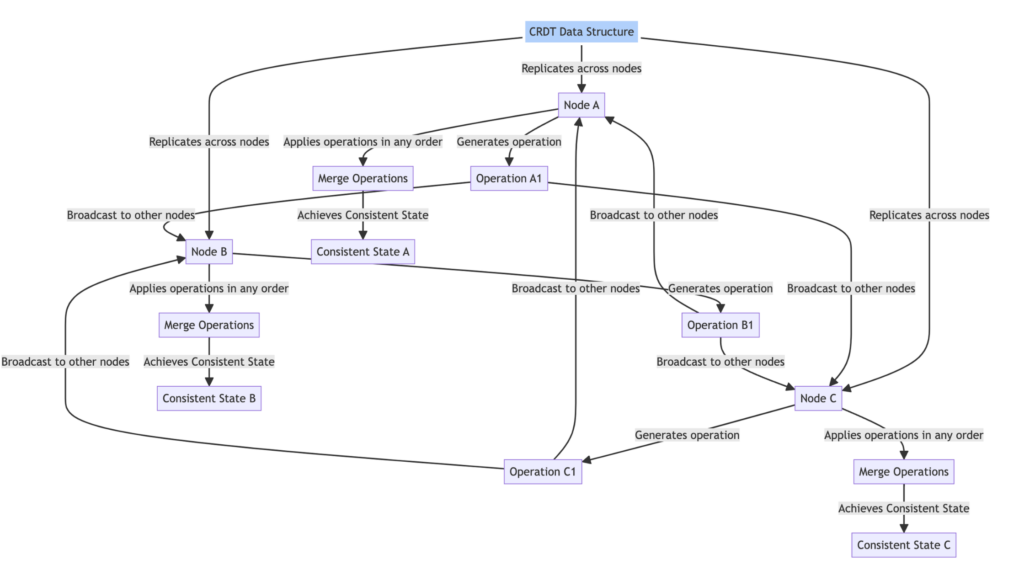
Types of CRDTs
There are two primary types of CRDTs: State-based (CvRDTs) and Operation-based (CmRDTs).
- State-based CRDTs (Convergent Replicated Data Types, CvRDTs): These CRDTs merge changes by sharing and merging the entire state of a data structure. When a node makes a change, it increments a version counter. Other nodes merge this updated state with their own, using the version counters to resolve any conflicts.
- Operation-based CRDTs (Commutative Replicated Data Types, CmRDTs): Instead of sharing the entire state, CmRDTs propagate operations (or changes) to all nodes. These operations are designed to be commutative. Each operation must contain enough context to be applied independently by other nodes, ensuring convergence.
How CRDTs Work in Collaborative Editing?
In a collaborative text editor utilizing CRDTs, each character in the document can be considered an element in a CRDT set. Each element has a unique identifier that encodes its position and authorship information, allowing characters to be inserted or deleted without conflicts.
When a user makes an edit, the operation (addition or deletion of a character) is broadcast to all participants along with its unique identifier. Other participants apply these operations locally, and due to the commutative property of CRDTs, the order of applying these operations does not matter. The result is a consistent document state across all participants, even if they make concurrent edits.
Challenges and Solutions
While CRDTs solve many problems related to real-time collaboration, they also present challenges, such as increased memory usage due to metadata overhead and complexity in designing CRDT data structures. However, the benefits, especially in enabling offline work and reducing the need for conflict resolution logic, often outweigh these challenges.
CRDTs represent a powerful paradigm for building distributed applications that require strong eventual consistency. By leveraging CRDTs, applications like Zed can offer real-time collaborative editing features, ensuring that all users see a consistent view of the document, regardless of network conditions or concurrent edits.
Zed’s Collaboration Workflow with CRDTs
- Initialization: When a collaborative editing session starts, Zed initializes the document state and distributes it to all participants.
- Local Editing: As users edit the document, their changes are applied locally first. Each change generates CRDT operations that are timestamped and sequenced.
- Broadcast and Merge: These operations are then broadcast to all other participants in the session. Upon receiving operations from others, each client merges them into their local document state using the CRDT algorithms, ensuring consistency across all sessions.
- Conflict Resolution: Due to the commutative nature of CRDT operations, conflicts are resolved automatically, and all users end up with identical document states after all operations have been applied.
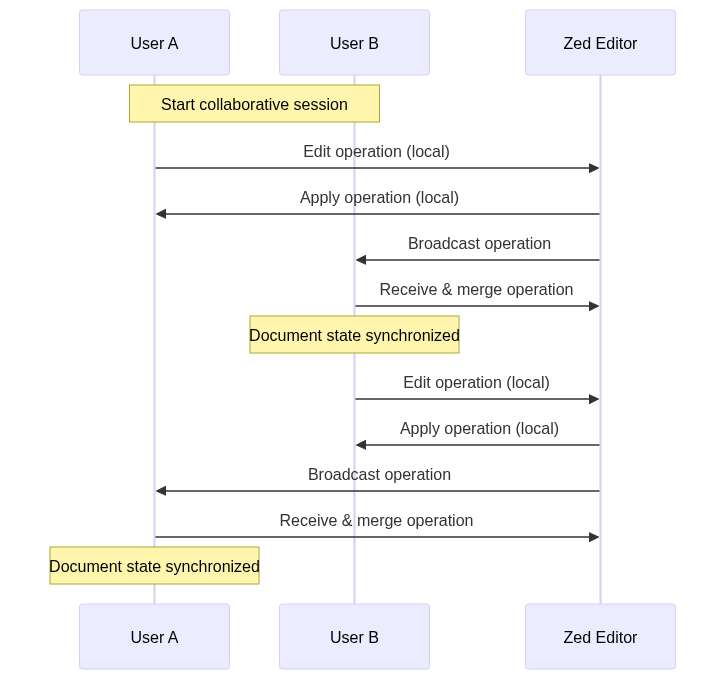
Implementing real-time collaboration with CRDTs allows Zed to provide a seamless and intuitive coding experience for teams, facilitating efficient and effective collaboration on software projects. This approach underscores Zed’s commitment to leveraging advanced technologies to solve practical challenges in software development workflows.
Zed’s Performance Benchmarking:
The efficiency of a code editor is not just a convenience but a necessity. Zed, emerging as a formidable contender in this space, has set new benchmarks for what developers can expect in terms of performance.
Comparative Performance Analysis
Zed’s architecture and choice of technologies have culminated in impressive performance metrics, notably outpacing competitors across key aspects:
- Startup Time: The time it takes for the editor to launch and be ready for use.
- Memory Footprint: The amount of RAM the editor consumes during operation.
- Insertion Latency: The delay between typing and the text appearing on the screen.
The table below encapsulates Zed’s efficiency in these areas compared to its counterparts:
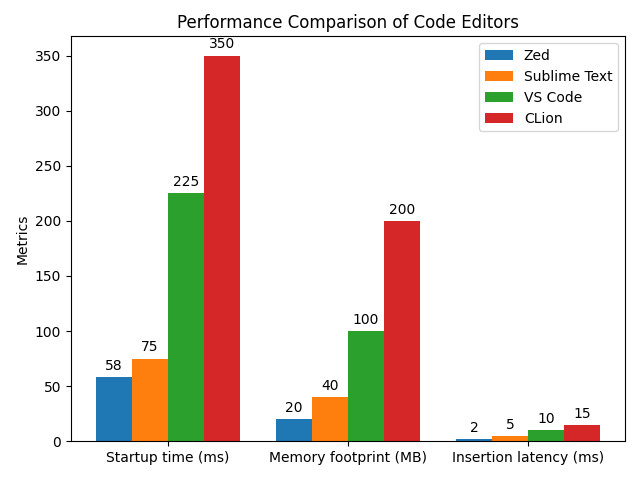
The chart offers a concise performance comparison among Zed, Sublime Text, VS Code, and CLion, focusing on startup time, memory use, and insertion latency. Zed leads in all categories, highlighting its efficiency and the impact of its technical optimizations. This analysis positions Zed as a preferred choice for developers seeking a fast and responsive code editor.
These figures not only highlight Zed’s superior performance but also reflect the effectiveness of its underlying optimizations.
Behind Zed’s Performance
The performance of Zed, a cutting-edge code editor, is not just incidental but a result of deliberate technological choices and optimizations. Here’s a deeper look into the factors that contribute to Zed’s standout performance:
- Rust Programming Language: Rust is at the core of Zed’s development philosophy, chosen for its emphasis on speed, concurrency, and memory safety. Unlike languages that rely heavily on garbage collection, Rust provides deterministic memory management without sacrificing performance. This means Zed can handle complex operations and large projects with ease, contributing to its rapid startup times and efficient memory usage.
- LLVM Compiler Infrastructure: LLVM plays a crucial role in optimizing Rust code into highly efficient machine code. This compiler infrastructure is known for its ability to generate fast and optimized binaries across various platforms. For Zed, LLVM ensures that the performance benefits of Rust are fully realized, significantly enhancing its execution speed and responsiveness.
- DirectX for Graphics Rendering: Graphics rendering is a critical aspect of code editor performance, especially for features like syntax highlighting and UI responsiveness. Zed uses DirectX, a collection of APIs for handling multimedia tasks on Microsoft platforms, to accelerate graphics rendering. By leveraging the GPU, DirectX allows Zed to maintain smooth and responsive visuals even during intensive operations, reducing insertion latency to nearly imperceptible levels.
- Minimal Dependency Overhead: A lean set of dependencies ensures that Zed remains lightweight and fast. By minimizing its reliance on external libraries and frameworks, Zed can maintain a small memory footprint and quick startup time. This approach contrasts with some editors that may become bloated over time, affecting their performance and usability.
The cumulative effect of these optimizations is an editor that stands out in the realms of startup time, memory efficiency, and operational speed. Rust’s safety and performance, combined with LLVM’s optimization capabilities, set a solid foundation. DirectX’s efficient rendering and the strategic minimization of dependencies further augment Zed’s responsiveness and efficiency, making it a top choice for developers who value speed and fluidity in their workflow.
By integrating these technologies and principles, Zed not only meets the current demands for software development tools but also sets new benchmarks for what developers can expect from a modern code editor.
Zed sets a new standard for code editor performance, as evidenced by its benchmarking against industry staples like Sublime Text, VS Code, and CLion. Through its judicious use of Rust, LLVM, DirectX, and a minimalistic approach to dependencies, Zed offers an unparalleled development experience. These optimizations not only make Zed a highly performant tool but also underscore its potential to boost productivity and efficiency in software development workflows.
Conclusion:
Throughout this blog, we’ve talked about the technical architecture, performance benchmarks, and the key optimizations that distinguish Zed as a high-performance code editor. By comparing Zed against popular editors like Sublime Text, VS Code, and CLion, we’ve illustrated its superior startup times, lower memory footprint, and reduced insertion latency. These advantages are attributed to strategic choices in Zed’s development, including the use of Rust for its core programming, LLVM for code compilation, DirectX for graphics rendering, and a minimal approach to dependencies.
Zed’s implementation of real-time collaboration through CRDTs has been a focal point, showcasing its capability to enable seamless, concurrent editing sessions among developers. This feature, alongside its technical optimizations, places Zed at the forefront of code editor performance, offering a solution that not only enhances individual productivity but also fosters team collaboration.
In conclusion, Zed represents a significant leap forward in code editor technology, setting new benchmarks for performance and collaboration. For developers seeking an efficient, responsive, and collaborative coding environment, Zed emerges as a compelling choice. Its advancements in technology and design philosophies underscore a commitment to addressing the evolving needs of the software development community, making it a standout tool in a crowded field of code editors.
